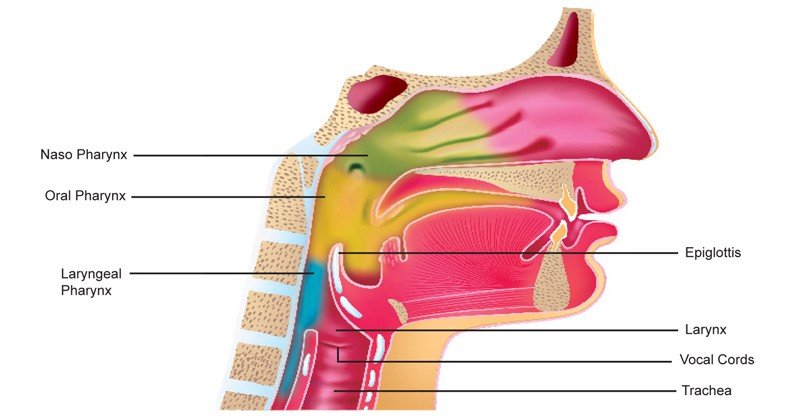Pharynx
The pharynx is a muscular tube which extends from the base of the skull to the oesophagus. It makes a bridge between the nasal cavity and the larynx and the oesophagus. It is common to both the respiratory tract and the digestive tract. In the respiratory tract it acts as an air passage during breathing, and in the digestive tract it acts as a food passage during swallowing.
Larynx
The larynx is the voice box, located above the trachea. This organ of vocal sound production also serves as an air passage between the pharynx and the trachea. The larynx is composed of the pieces of cartilage. The largest of these is thyroid cartilage and then Adam’s apple in front of the neck. The larynx forms an opening between the pharynx and the trachea (wind pipe). Larynx also provides a base for the epiglottis and vocal cords.

Epiglottis
Epiglottis is a flexible flap made up of cartilaginous tissues, located behind the tongue. It helps to close off the larynx during the swallowing of food. This is a very crucial function. This situation can make a human being very uncomfortable. So, it performs an important function by guiding food towards the oesophagus.
Vocal Cords
Vocal cords are two belts of tissue stretched across the larynx. The voice is produced due to the vibration of the cords. These cords vibrate due to the air passing through the glottis. Various muscles attached to the larynx control the production of the voice. Other organs of sound production and speech include the mouth, tongue, teeth, lips, nose, paranasal sinuses, pharynx (throat), trachea (wind pipe) and lungs.
Trachea
The trachea or wind pipe extends from the larynx. It is composed of 16-20 incomplete rings of cartilage connected with fibrous tissues. The trachea is lined by the mucous membrane. The movement of muscles in the trachea is upward; upward movement expels the inhaled dust and pollen particles. The main function of the trachea is to act as a passageway for air between the larynx and the lungs.


